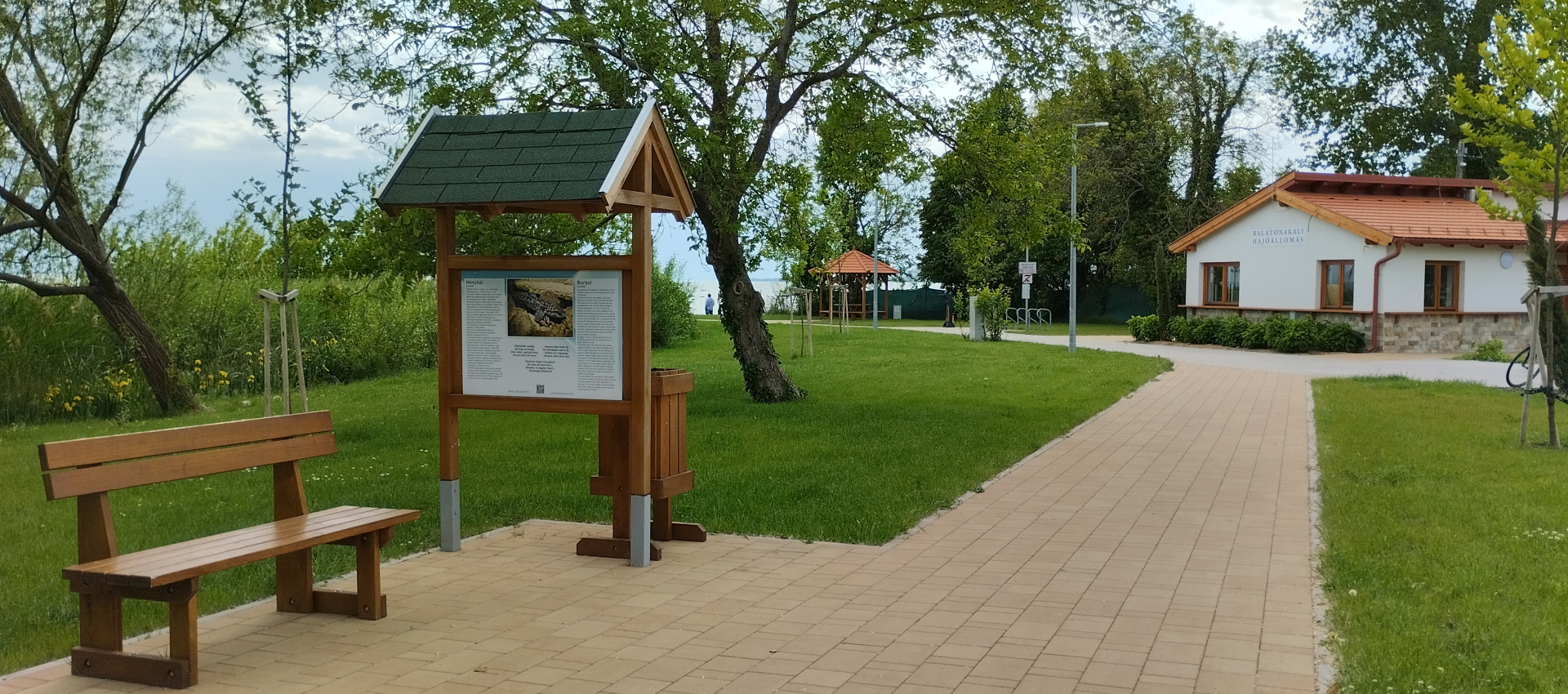
A Pántlika-kastély az 1920-as években.

A kastély napjainkban.
A környékünkön ritkán látható, mutatós kerámia díszíti a valamikori római katolikus parókia homlokzatát. A bokrok takarásában megbújó, Szent Józsefet és a kisded Jézust ábrázoló alkotás párhuzamaira Pécsett bukkantunk, így feltételezésünk szerint a Zsolnay porcelángyár terméke lehet.
József a kezében liliomot tart, mint Mária szüzességének oltalmazója, míg a gyermek Jézusnál lévő aranyalma a bűn leküzdésére, Krisztus megváltói küldetésére utal.
Az épület sajnos – helyi plébános hiányában – évtizedek óta üresen várja, hogy új funkciót kapjon.
Akali, mint arról később is meggyőződhetünk, a legtöbb Balaton-felvidéki településhez hasonlóan vegyes felekezetűnek számított, így minden településen élt egy kisebb-nagyobb zsidó közösség is. Nálunk ennek állít emléket a „zsidóköz” kifejezés, mellyel ezt a kis utcát jelöli a helyi népnyelv, nem véletlenül! Ugyanis a sarki épületben működött sokáig a helyi kocsma és bolt, melynek zsidó családok voltak a tulajdonosai, illetve bérlői. A ma is látható lemeszelt vasajtó tehát nem véletlenül nyílt a főutcára.
A portát évtizedekkel ezelőtt vásárolta meg Paulikovics Pál képzőművész, aki a falu tiszteleti polgára. Az ő alkotása a helyi betlehem is, de háza udvarán is látható több munkája.
Ha a két épület közt az út közepére állunk és északi irányba tekintünk, a szemünk a távolban megakad a Pántlika-kastélynak nevezett hatalmas épületen, amely az 1870-es évektől a második világháborúig a piaristák híres borászati központja volt, jelenleg magántulajdon.
József a kezében liliomot tart, mint Mária szüzességének oltalmazója, míg a gyermek Jézusnál lévő aranyalma a bűn leküzdésére, Krisztus megváltói küldetésére utal.
Az épület sajnos – helyi plébános hiányában – évtizedek óta üresen várja, hogy új funkciót kapjon.
Akali, mint arról később is meggyőződhetünk, a legtöbb Balaton-felvidéki településhez hasonlóan vegyes felekezetűnek számított, így minden településen élt egy kisebb-nagyobb zsidó közösség is. Nálunk ennek állít emléket a „zsidóköz” kifejezés, mellyel ezt a kis utcát jelöli a helyi népnyelv, nem véletlenül! Ugyanis a sarki épületben működött sokáig a helyi kocsma és bolt, melynek zsidó családok voltak a tulajdonosai, illetve bérlői. A ma is látható lemeszelt vasajtó tehát nem véletlenül nyílt a főutcára.
A portát évtizedekkel ezelőtt vásárolta meg Paulikovics Pál képzőművész, aki a falu tiszteleti polgára. Az ő alkotása a helyi betlehem is, de háza udvarán is látható több munkája.
Ha a két épület közt az út közepére állunk és északi irányba tekintünk, a szemünk a távolban megakad a Pántlika-kastélynak nevezett hatalmas épületen, amely az 1870-es évektől a második világháborúig a piaristák híres borászati központja volt, jelenleg magántulajdon.
5. Story-telling street corner


The façade of the former Roman Catholic parish is adorned with a striking ceramic decoration rarely seen in our area. In Pécs, we found similar work depicting St. Joseph and the infant Jesus hiding in the bushes, so we assume it could be a product of the Zsolnay porcelain factory.
Joseph is holding a lily in his hand as the protector of Mary's virginity, while the golden apple on the child Jesus refers to the overcoming of sin and Christ's mission as a saviour.
Sadly, in the absence of a local parish priest, the building has been vacant for decades, waiting for a new function.
As we will see later, Akali, like most of the settlements in the Balaton Uplands, was populated by different religions. For example, there was a Jewish community of some size in every settlement. In our village, this is commemorated by the term "Jewish lane”, which is used in the local vernacular to describe this small street, and for good reason! For a long time, the local tavern and shop, owned and rented by Jewish families, operated in the building on the corner. It is, therefore, no coincidence that the whitewashed iron door, still visible today, opened onto the main street.
This property was bought decades ago by the artist Pál Paulikovics, an honorary citizen of the village. He is also the creator of the local nativity scene, and several of his works can be seen in the courtyard of his house.
If you stand in the middle of the road between the two buildings and look north, your eyes will be caught in the distance by the huge building known as the Pántlika Castle, which was the famous wine-making centre of the Piarists from the 1870s until the Second World War, and is now privately owned.
Joseph is holding a lily in his hand as the protector of Mary's virginity, while the golden apple on the child Jesus refers to the overcoming of sin and Christ's mission as a saviour.
Sadly, in the absence of a local parish priest, the building has been vacant for decades, waiting for a new function.
As we will see later, Akali, like most of the settlements in the Balaton Uplands, was populated by different religions. For example, there was a Jewish community of some size in every settlement. In our village, this is commemorated by the term "Jewish lane”, which is used in the local vernacular to describe this small street, and for good reason! For a long time, the local tavern and shop, owned and rented by Jewish families, operated in the building on the corner. It is, therefore, no coincidence that the whitewashed iron door, still visible today, opened onto the main street.
This property was bought decades ago by the artist Pál Paulikovics, an honorary citizen of the village. He is also the creator of the local nativity scene, and several of his works can be seen in the courtyard of his house.
If you stand in the middle of the road between the two buildings and look north, your eyes will be caught in the distance by the huge building known as the Pántlika Castle, which was the famous wine-making centre of the Piarists from the 1870s until the Second World War, and is now privately owned.








